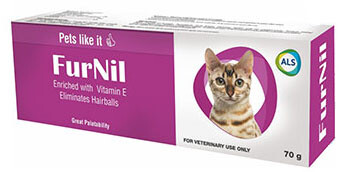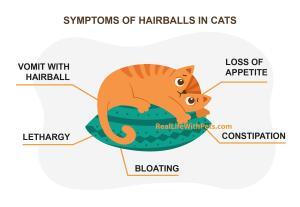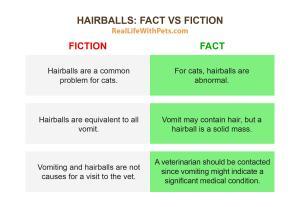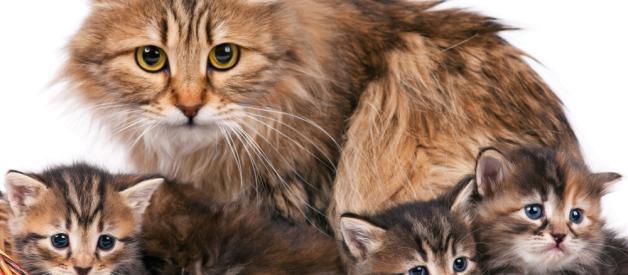Table of Contents
Trichobezoar is a medical or scientific term used to describe a hairball. “Trich” means hair, while a bezoar is any foreign material obstructing the stomach or intestines. Therefore, a trichobezoar is a gastrointestinal obstruction caused by hair.
While hairballs are typically attributed to cats, they can also cause problems in dogs. Any dog or cat that grooms themselves, or eats the hair of others, is at risk of developing a trichobezoar.
What Causes Trichobezoars?
As they groom themselves, cats are continuously consuming small amounts of hair. Due to the keratin (a fibrous, structural protein), this hair cannot be digested; as a result, it often passes through the intestines and exits the body in the feces. A hairball or trichobezoar may develop due to the tangled mass of hair grown too huge to pass through the bowels.
The hairball is a mixture of stomach acid, mucus, and of course, hair, it can vary in texture and color, but usually, they are some shade of brown, green, or orange.
Once hairball forms, there are two possible outcomes. Many cats simply vomit up the hairball, leaving you to discover it on your floor, and continue on with their everyday lives. Fur may also exit the body as feces after passing directly through the digestive system. In cats, the digestion process lasts 7–12 hours. Hairballs can also occur when hair gathers in the stomach. Healthy hairballs should pass within 24 to 48 hours; sometimes, this process takes a little longer. In some cases, however, this hairball may become lodged in the gastrointestinal tract, leading to an obstruction.
Trichobezoars are more common in cats with underlying gastrointestinal diseases. These cats may have altered gastrointestinal motility that limits the movement of hair through the digestive tract. Additionally, cats with allergies or other types of skin disease may be more prone to trichobezoars due to more vigorous licking at their skin and coat.
Large hairballs can be challenging for your cat to pass, which can be uncomfortable and upsetting. They might also hurt. A huge hairball will form when too much hair accumulates and cannot be eliminated naturally.
A large hairball can cause a blockage in a cat’s intestinal tract and cause your cat to choke to death. A cat should pass a hairball in less than a day; if your cat is gagging for longer, take him to the doctor so he can be examined. Your cat may get dehydrated if it gags and retches frequently. In addition, cats can die from being obstructed for 24 hours.
Signs of a Trichobezoar
A vomited hairball is frequently the only indication that your pet has a trichobezoar. Most cat owners can quickly recognize these tubular-shaped wet hair accumulations. The pressures that compress the mass of hair as it ascends the esophagus give them their tubular shape.
Trichobezoars that cause obstruction, however, are more difficult to get rid of. You might not notice hair in your pet’s vomit if a trichobezoar is an impediment. Vomiting, pain in the abdomen, and an inability to urinate are symptoms indicating a blockage. You should take your cat to the vet if he doesn’t want to drink or eat.
Prevention of Trichobezoars
Several methods have been used to stop cats from developing hairballs. Working with your veterinarian to treat any underlying digestive diseases is perhaps the most crucial step. Cats may be more susceptible to trichobezoars if anything affects their digestive system. To reduce ingesting hair, skin conditions should also be considered.
Consult your vet to see if your cat would benefit from a diet to prevent hairballs. These diets have high fiber content to pass hair through the digestive system and lessen the chance of trichobezoars developing. To lower the risk of trichobezoars, your veterinarian may also suggest nutrients or treatments.
A natural lubricant like water helps reduce the formation of hairballs. Make sure your cat has access to plenty of fresh, clean water by placing water bowls or cat drinking fountains in several locations, so they always have easy access.
6 Steps to Prevent Hairballs
1. As they are caused by excessive amounts of hair, regularly grooming your cat to remove loose hair will go a long way towards preventing hairballs. The more fur you remove from your cat, the less fur will end up as hairballs in their stomach.
2. Keep a diet and give more water.
3. Use a hairball product or laxative.
4. Discourage excessive grooming.
5. Easy access to fresh, clean water.
6. If your cat won’t sit still for you to comb them, booking regular appointments with professional groomers (either for a comb-out, bath, or haircut) may be helpful.
What Is Furnil (Liquid Paraffin + Vitamin E) Paste for Cats and Kitten?
Furnil is a protective means from trichobezoar and is used to treat cats and kittens. It is an oral paste, and each tube contains 70g of paraffin plus Vitamin E. The medication is effective for normalizing the digestion process in cats and thus preventing the formation of trichobezoars.

The active ingredient in Furnil is psyllium, which helps to break down the hairball and pass it through the digestive system.
Medicine keeps the cats active and vigorous and has excellent tastefulness, providing easy feeding and promoting natural cleansing of the body.
The manufacturer of Furnil (Liquid Paraffin + Vitamin E) is Ashish Life Science Pvt. Limited. This is a reputed exporter working in India and supplying products worldwide.
Effectiveness
Furnil for cats is a veterinary medication produced in tubes. Its main ingredient is paraffin. By 2022 it has proved its effectiveness in treating and protecting animals from trichobezoar, also known as a hairball.
The Furnil advantages list is impressive. First, the medicine won’t affect your kitten or cat’s appetite since it is quite palatable for cats. Instead, the medication’s measured uses improve the animal’s digestion and make your pet lively and active. Moreover, you won’t be disappointed with Furnil’s cost in 2022 compared with similar pastes.
Ingredients
Furnil (Liquid Paraffin + Vitamin E) has quite a complicated composition. However, the medication does not contain any dangerous components for your pet. Each 5 g of the medicine contains (Guaranteed Analysis):
- Liquid Paraffin (Mineral Oil/Petrolatum) – 2 g;
- Vitamin E (all-rac-Alpha-Tocopheryl Acetate) – 6 IU;
- Malt as a source of proteins;
- Glycerin;
- Sorbic acid, hydroxybenzoic acid propyl ester, and methyl hydroxybenzoate as preservatives;
- Stabilizer E414 arabic gum;
- Sugar;
- Crude protein, crude fiber, coarse fats.
Each capsule contains 70g of the medication.
Uses of Furnil Oral Paste
You may buy Furnil not only to prevent hairball cases with your cat but also to improve your animal’s digestive system. Moreover, the medication will make your cat energetic and active. It also helps with the natural cleansing of your kitten’s body.
Furnil Oral Paste is used in cats to:
- prevent the occurrence of common trichobacteria in cats by maintaining healthy digestion;
- keep cats active and vigorous;
- facilitate feeding by excellent palatability;
- promote natural cleansing of the body with the help of proteins and vitamins.
Symptoms of Hairballs in Cats
- Ongoing vomiting, gagging, retching, or hacking without producing a hairball.
- Lack of appetite.
- Lethargy.
- Constipation.
- Diarrhea.
Signs of a complete intestinal blockage include:
- uncharacteristic behavior or aggression;
- abdominal pain;
- vomiting;
- lack of energy;
- diarrhea;
- lack of appetite;
- drooling;
- the appearance of a partial item from the anus.

Furnil Dosage
Consult a vet to determine the correct dosage for your pet. But in general, if you give the paste to your pet as a preventive means or to get rid of hairballs, stick to the following doses:
|
|
Dosage for Prevention |
Dosage for Treatment |
|
Cats |
½ teaspoon once a week |
½ teaspoon during 3 days or 2-3 days per week |
|
Kittens from 6 weeks |
¼ teaspoon once a week |
¼ teaspoon during 3 days or 2-3 days per week |
This product is intended for intermittent or supplemental feeding only.
Hairball remedies are given daily for some period of time. However, if your cat has food allergies or is taking other oral medications, talk to your veterinarian before starting a supplement or hairball remedy to ensure it is safe.
Withdrawal Time
The medicine is almost entirely absorbed by the body because vitamins and minerals make up the paste’s composition. The exact withdrawal time is not provided by the manufacturer. Never take more medication than is advised, and you won’t have to worry about managing the medication’s withdrawal symptoms.
Important Safety Information for Cat Owners
While hairballs are common, they’re actually not “normal.” Let’s take a closer look at their formation to understand why.
A healthy cat will spend a lot of time grooming itself, removing, and swallowing lost hair. This occurs because their tongues are covered in many tiny barbs that face backward and snag hair to transport it into their digestive systems.
Most cats don’t have any problems as eaten hair usually passes their digestive tract naturally.
However, some cats will collect so much hair in their digestive tracts that it causes an obstruction that can be expelled as a hairball. These hairballs are often caused by ingesting excess amounts of hair through overgrooming (common with skin conditions, painful areas, or stress) or by having trouble moving the hair through their system (which can occur with gastrointestinal diseases or certain medications).
Even though these instances are relatively rare, cats might, unfortunately, become ill from particularly large and immovable hairballs. They risk developing hairballs if their hair isn’t correctly expelled through their digestive system. These masses of hair can cause regurgitation, constipation, esophageal obstructions, loss of appetite, and ultimately weight loss. No matter how long their coats are, cats should only create one hairball weekly.
Some cats will get more hairballs when the temperature increases in the spring and summer. This may be because the cats are grooming themselves more in preparation for the hotter summer months, and their coats are shedding more. Some cats get more hairballs in winter when they begin shedding their winter coats.
There is nothing to be concerned about if your cat is healthy and gets hairballs every couple of weeks. However, if it occurs more frequently (for instance, a few times a week or more frequently), you should visit your neighborhood cat doctor for an examination.
Frequent hairballs may indicate an underlying health issue in your cat, such as anxiety, allergies, or an unbalanced gut microbiota (the community of bacteria in the digestive tract). Therefore, make an appointment with your veterinarian if your cat is not eating or is vomiting hairballs more frequently or without producing any.
A hairball doesn’t resemble a ball at all. In reality, as hairballs are long, dense, tubular bundles, “hair sausage” could be a better visual description (typically about the width of a thumb). The way the hair gathers and wads together in the stomach is what gives the body this characteristic form. Additionally, a cigar-shaped object is much simpler to pass out of the stomach than a round ball.
Do not exceed the recommended dose.

Palatability
Furnil Oral Paste is highly palatable. This extra nutrition drug is easy to give your pet and has a pleasant taste. Use a teaspoon to measure the dose. Then, put the medicine directly into the cat’s mouth.
Veterinary Prescription
A veterinarian should prescribe Furnil after diagnosis.
The cause of your cat’s hairball vomiting is easy to determine. To look for underlying reasons of your cat’s hairballs, your veterinarian may advise diagnostic procedures:
- complete skin examination;
- blood tests;
- gastrointestinal testing.
Additional tests will be required to determine whether a trichobezoar is the cause of the obstruction. Your pet’s physical examination will start with a thorough evaluation of its general health. Your veterinarian will also massage your pet’s belly for any indications of intestinal disease or obstruction. After that, your veterinarian probably suggests imaging to check for signs of an obstruction. Radiographs (x-rays) are typically the initial step in determining whether an obstruction has occurred. Then, depending on your cat’s radiographs, your veterinarian might suggest further imaging.
In exceptional circumstances, your vet might advise removal using an endoscope that can be inserted into the stomach and down your cat’s throat. However, surgical removal is more frequently carried out. This is because your cat’s whole digestive system can be accessed during surgery, allowing your vet to check for any potential obstructions and, if necessary, remove trichobezoars from various locations.
Most cats react well to surgery as long as it is done quickly before severe intestinal damage has developed. Your veterinarian will discuss your cat’s prognosis before surgery and the necessary aftercare with you. Most patients remain hospitalized for one to three days after surgery and are sent home with a specific diet, medication, and exercise restriction instructions.
To avoid obstruction and surgery, the owners must prevent severe cases and give Furnil Oral Paste to their pets.
Side Effects
Furnil is safe and side effects are rare. However, sometimes vomiting may be a side effect, especially if your kitten is only six weeks or less.
Furnil is available as an easy-to-use paste that may be put right into your cat’s mouth. Furnil has many benefits, including the fast dissolution of hairballs and the absence of adverse effects. However, the cons of this drug include the possibility of gastrointestinal distress if too much is administered at once.
Benefits of Using
- Preserving good digestion helps in the prevention and removal of common feline hairballs.
- Keeps the kitty energetic and active.
- It helps the body naturally cleanse itself with protein and vitamins.
Storage
Keep out of the reach of children.
Do not store above 30°C. Protect from light.
FAQs
Where to Buy Furnil?
You can find the best price in 2022 for Furnil and purchase the drug online.
Are There Any Analogues of Furnil?
Many pharmaceutical companies produce liquid paraffin. However, Furnil has many unique qualities. For instance, its formula contains Vitamin E.
How Do Vets Treat a Cat With a Hairball Blockage?
If a blockage is detected, first vets prescribe medicines, like Furnil, to move the hairball through the digestive tract. If it doesn’t help, therapy will include protecting the intestine through several days of clinical care, including intravenous rehydration and a laxative. The last step is surgery, as the only way to remove the hairball.
What Can I Give My Cat to Dissolve Hairballs?
First, you need to contact your vet to get a prescription for lubricate, like Furnil. Then, in your everyday life, give your cat a small amount of canned tuna or sardines occasionally. And from time to time, continue giving Furnil to prevent hairballs.
Can a Cat Still Poop if They Have a Blockage?
Food consumed by a cat passes via the stomach, small intestine, large intestine, colon, and anus as excrement. Nothing can pass through a blocked intestine, though.
How Do Cats Act if They Have a Blockage?
Among other issues, typical symptoms include sobbing, refusing to lie down, fatigue and lethargy, nausea, vomiting, abdominal pain or swelling, and weakness. You should immediately take your cat to the vet if they exhibit any of these symptoms.
How Common Are Hairballs For Cats?
While most of the swallowed hair eventually passes through the animal’s digestive tract and gets excreted intact in the feces, some remains in the stomach and gradually accumulates into a damp clump — the hairball. It’s not uncommon for a cat to regurgitate a hairball once every week or two.
Can Hairballs Cause Bowel Obstruction?
The blockage can be life-threatening if a hairball gets stuck in the digestive tract. In addition, gastrointestinal blockages require prompt surgical intervention, so if you suspect a blockage in your cat, see your veterinarian immediately.
Does Wet Cat Food Help With Hairballs?
Yes, wet food helps pass hair through the tract because it’s easy to digest, which means it passes through the body quickly, not allowing hair to form a ball. Therefore, cats on a diet of just wet food will have reduced hairballs.
Why is My Cat Gagging But Not Throwing Up?
Your cat may gag without vomiting if something is stuck in his throat. However, he can swell up in the abdomen and frequently gag and vomit if he has a clog in his digestive system. If this happens, take him to the veterinarian right away.
Can Hairballs Look Like Poop?
A hairball is usually shaped like a cylinder. If you see one on your favorite rug, you might mistake it at first for feces. Hairballs are often about the same size and shape as a log of cat poop.
What Does a Cat Sound Like When Coughing Up a Hairball?
When a cat is trying to bring up a hairball, it may start retching, gagging, or acting like they are dry heaving and trying to vomit. Sometimes the sound they make is called a ‘cough-gag-retch.’ This is because your cat can appear to be coughing from the lungs, gagging with their throat, and retching from the stomach.
Why Is My Cat Making Choking Sounds?
It usually indicates one of two things if your cat repeatedly makes choking noises, such as hacking, gagging, retching, or coughing. Your cat is either preparing to vomit up a hairball, or it has ingested something foreign that is blocking its windpipe.
How Do You Get a Cat to Pass a Blockage?
Your cat’s treatment plan will be given to you by your veterinarian, but it may include laxatives, endoscopy, stabilizing them if they’re dehydrated, and surgery as a last option. Your cat should be alright if you discover the obstruction in time.
When Should I Worry About My Cat Gagging?
Check your cat’s airways for any foreign items if she is gagging but not seeming to be spitting up any hairballs. If you spot something, call the emergency vet instead of attempting to remove it yourself. Getting a foreign thing out of your system might cause more harm than good.
What’s the Difference Between Hairball and Throw Up?
The vomited substance may be more rounded if the hair enters the stomach but does not pass through it. These hair strands in liquid (clear, foamy, or yellow) are “vomit with hair,” not hairballs.
Does Cat Grass Help With Hairballs?
Hairballs can be passed through their systems with the help of cat grass, or if they are too big to pass through their stomachs, they can be coughed up. Your cat can avoid developing stomach hairballs by regularly consuming cat grass. In addition, cat grass is a fantastic source of vitamins and its valuable fiber content.
How Do I Know If My Cat Has a Hairball or Asthma?
One method to detect the difference is to observe your cat’s posture. For example, your cat will be crouched lower to the ground during an asthma episode than she is when coughing up a hairball, and her head and neck will be extended to suck in more air.
Do Cats Lose Appetite When They Have a Hairball?
The most visible hairball symptom you’ve probably noticed is the retching and gagging that usually precedes the vomiting of the hairball. In addition to retching/gagging, your cat may experience a lack of appetite.
What Causes Cats to Throw Up White Foam?
White foam vomiting is pretty typical in cats. Typically, this indicates that the stomach is empty and the cat cannot bring anything up. It may indicate a food allergy or a blockage if the cat is not eating but appears to vomit white foam.
How Can I Stimulate My Cat to Have a Bowel Movement?
To improve the work of the digestive system, you need to give medicine to your cat, make constipation massage and keep your cat on a diet.
Can a Bowel Obstruction Go Away By Itself?
Complete blockages frequently necessitate a hospital stay and possibly surgery. However, if the bowel is only partially blocked, your vet may advise you to wait until it unblocks naturally. If so, you can take steps at home to help your pet feel better and give them Furnil prescribed by the vet.
Do Cat Hairball Treats Work?
Most over-the-counter hairball treatments include a mild laxative to encourage your cat to release hair via their bowels and petroleum jelly or mineral oil to lubricate their stomachs. These can be effective, but you should follow directions closely and not overdose. Try Furnil Oral Paste, and you will see its effectiveness.
Where Are Hairballs Stored in Cats?
Hairballs are collections of fur that form in your cat’s digestive tract as a result of grooming. Some of the hair that cats ingest is left in the stomach or small intestine, while most of it goes through the digestive tract and ends up in the feces.
Can Hairballs Cause Coughing in Cats?
It is typical for cats only to cough up a hairball 3-4 times a month, even though hairballs are frequently believed to be the source of cats’ coughing. If your cat coughs more often, this can be a symptom of other health issues.
Can Hairballs Cause Constipation in Cats?
Even while most cats don’t have issues with hairballs, some cats with underlying conditions can get constipation from blocked hairballs, which can lead to dehydration or a constricted pelvic canal. In addition, cats with long hair or those who groom themselves more frequently than usual, predisposed to stress or itching, are more likely to develop hairballs. Even mild stress is enough to cause healthy cats to vomit and pass hairballs.
Can Hairballs Cause Pancreatitis in Cats?
Internal parasites, pancreatitis, hernias, foreign objects, cancer, and other potentially dangerous conditions can all be associated with hairballs.
Do Hairballs Make Cats Sneeze?
It’s possible to aspirate hair into the nasopharynx (the upper part of the throat behind the nose). Sneezing, runny nose, coughing, and infection could result from this.
Why Is My Cat’s Hairball Green?
Green vomit from your cat is typically a sign that the food or substance was brought up through the small intestines. In addition, bile and vomitus can combine to turn the hairball green.
Can Hairballs Cause UTIs in Cats?
No, because hairballs are a symptom, not a diagnosis. A healthy cat should be able to handle a “normal amount” of swallowed hair without causing any harm to Urinary Tract System.
How Can I Tell the Difference Between a Hairball and Other Kinds of Vomit?
The proportion of hair to other materials is the primary indicator for distinguishing between vomit and hairballs. For example, a hairball will look like a tightly wound cigar with some digestive fluid surrounding it. In contrast, the vomit will mainly consist of liquids, bile, undigested food, and/or other things; however, some hair may also be present.
How Not to Confuse Coughing with Trying to Cough Up a Hairball?
Cats assume almost identical positions – and make almost identical sounds – when they cough and vomit. Unfortunately, this leads many owners to ignore their cat’s coughing, but it could be a symptom of a more serious medical issue, such as respiratory disease. It’s important to keep in mind that cats are excellent vomiters. So they will do so if they have anything in their tummies that has to come out. Therefore, if nothing is coming out, they are probably coughing rather than “trying” to vomit up.
Are Hairballs to Blame for My Cat’s Vomiting?
Although cats frequently vomit due to hairballs, this isn’t the only reason why it might happen. Eating inedible stuff like yarn, string, or anything they discover on the floor is another reason cats vomit. These items will generally be visible, making it simple to determine if this is what made your cat throw up.
What’s less obvious is whether your cat consumed anything poisonous, such as a poisonous plant, human medication, chocolate, or household chemicals, all of which can cause vomiting in cats. These vomiting symptoms are frequently accompanied by other ones, such as weakness, diarrhea, appetite loss, increased thirst, and either increased or decreased urination.

































